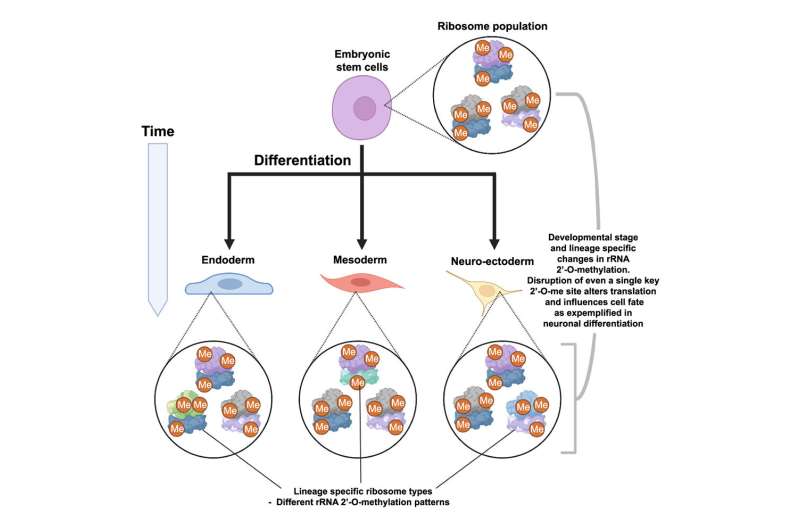This article has been reviewed according to Science X's editorial process and policies. Editors have highlighted the following attributes while ensuring the content's credibility:
fact-checked
peer-reviewed publication
trusted source
proofread
Examining the role of ribosomes in the development of new treatments

The human body consists of trillions of cells, and 60% of the energy used within a cell is dedicated to a specific molecular machine. That machine is responsible for producing proteins, which are fundamental building blocks of the body.
The molecular machine is called a ribosome. The ribosome's task is to create proteins based on a copy of the genetic code found in the genome, known as mRNA. Until now, scientists believed that the ribosome performed the same type of work with all mRNA, like a standardized assembly line that it did not regulate on its own.
However, researchers from the University of Copenhagen have discovered that this is not the case.
"It has long been known that there are different types of ribosomes. But it has been assumed that no matter what mRNA you give the ribosome, it will produce a protein. But our results suggest that different types of ribosomes produce specific proteins," says Anders H. Lund, Professor at the Biotech Research and Innovation Centre at the University of Copenhagen.
Anders H. Lund and his colleagues found that cancer cells have different ribosomes compared to other cells, and that was the basis for the new discovery. Their paper is published in the journal Developmental Cell.
"This led us to speculate why this is the case. Perhaps cancer cells need specific proteins to grow, form metastases, or undergo other types of development? This made us consider why various types of ribosomes exist and how they are vital for the body's development," says Anders H. Lund.
The study, conducted in collaboration with adjunct Sophia Häfner as the first author, was carried out in both mouse brains and human stem cells. According to Anders H. Lund, this provides a strong indication that the results are applicable to many forms of life.
A small change with significant implications
The researchers began by examining brains from mice from the fetal stage and onwards. They found that the brain's ribosomes changed throughout development, suggesting that ribosomal changes are necessary for regular development.
To investigate whether the same applies to humans, the researchers used human stem cells, which can differentiate into many different cell types found in the human body.
"We induced the cells to differentiate into various cell types and tracked them during development. We then examined whether the ribosomes had changed, and indeed, we observed that they did," says Anders H. Lund.
Ribosomes have a specific pattern with 114 small chemical modifications. These modifications change during cell differentiation and, according to the researchers, may form a code that determines which proteins the ribosome produces.
"If we remove a single modification and differentiate stem cells into nerve cells, the ribosome will produce different types of nerve cells than usual. Thus, the appearance of the ribosome is essential for what the cells can become over time," says Anders H. Lund.
"In this way, we demonstrated that the ribosome is not just a passive "translator" of mRNA into protein but rather has an active, regulatory function."
Improved treatments in the future
Currently, there is already considerable research in stem cells, focusing on how to create specific types of cells, such as nerve cells. This new knowledge is therefore essential for understanding how the body's cells develop. Moreover, it may enable us to develop improved treatments in the future.
"Our results suggest that we may be able to control this process better because we now know more about what regulates the production of specific proteins. It may also shed light on the biological processes that are crucial for the development of specific cell types. This knowledge could potentially be used in regenerative medicine," says Anders H. Lund.
Regenerative medicine involves treatments where healthy cells are transplanted into patients to help restore normal body function. It can be used in diseases like diabetes or Parkinson's disease.
In the future, these findings may also lead to better treatments for cancer.
"It all started when we observed that ribosomes looked different in cancer cells compared to healthy cells. When ribosomes are different, we may be able to develop a substance that can bind to and possibly inhibit, or paralyze, some of the ribosomes that are abundant in cancer cells. This could offer new treatment possibilities," says Anders H. Lund.
More information: Sophia J. Häfner et al, Ribosomal RNA 2′-O-methylation dynamics impact cell fate decisions, Developmental Cell (2023). DOI: 10.1016/j.devcel.2023.06.007
Journal information: Developmental Cell
Provided by University of Copenhagen





















